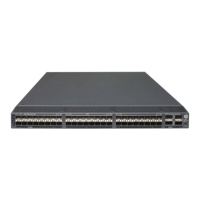119
Configuring BFD
The term "interface" in this chapter typically refers to Layer 3 interfaces, including VLAN interfaces and
Layer 3 Ethernet interfaces. You can set an Ethernet port as a Layer 3 interface by using the port
link-mode route command (see Layer 2—LAN Switching Configuration Guide).
The following commands can be configured in Layer 2 aggregate interface view:
• bfd authentication-mode
• bfd detect-multiplier
• bfd min-receive-interval
• bfd min-transmit-interval
For more information about configuring BFD on Layer 2 aggregate interfaces, see Layer 2—LAN
Switching Configuration Guide.
Introduction to BFD
Bidirectional forwarding detection (BFD) provides a general-purpose, standard, medium- and
protocol-independent fast failure detection mechanism. It can detect and monitor the connectivity of links
in IP to detect communication failures quickly so that measures can be taken to ensure service continuity
and enhance network availability.
BFD can uniformly and quickly detect the failures of the bidirectional forwarding paths between two
devices for upper-layer protocols such as routing protocols and MPLS. The hello mechanism used by
upper layer protocols needs seconds to detect a link failure, while BFD can provide detection measured
in milliseconds.
BFD can be used for single-hop and multi-hop detections:
• Single-hop detection—Detects the IP connectivity between two directly connected systems.
• Multi-hop detection—Detects any of the paths between two systems. These paths have multiple
hops, and might overlap.
BFD session establishment
BFD provides no neighbor discovery mechanism. Protocols that BFD services notify BFD of routers to
which it needs to establish sessions.
BFD sessions are established as follows:
1. A protocol sends Hello messages to discover neighbors and establish neighborships.
2. After establishing neighborships, the protocol notifies BFD of the neighbor information, including
destination and source addresses.
3. BFD uses the information to establish BFD sessions.
When BFD detects a link failure:
1. BFD clears the neighbor session.
2. BFD notifies the protocol of the failure.

